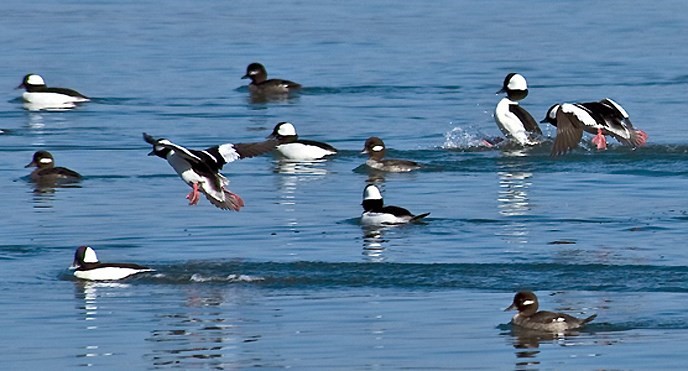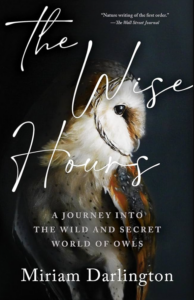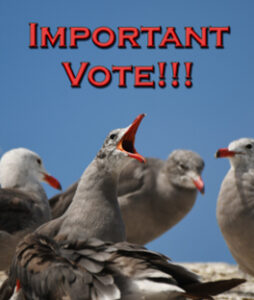Bucephala albeola
Order: Anseriformes
Family: Anatidae
by Sharon L. Moore
How delightful it is to anticipate the arrival of the diminutive Bufflehead as they migrate to our south Puget Sound waters after a long summer raising their young in Canada’s rich, vast boreal forest landscape. The black and white-patterned Bufflehead is heavily reliant on the boreal for nesting sites and sufficient food sources; in fact, 80% of its population breeds there. Now they’re winging back to us, and will soon be holding our attention with their buoyant paddling, near constant dives and rapid wing beats. Given this lively behavior, it’s no accident that they are sometimes called the hummingbirds of the duck world. In the next few weeks, take your binoculars or spotting scope to Capitol Lake, Budd Bay inlet or other relatively shallow city/county shore lines, and you’ll be quite certain to spot them.
As one of the smallest diving ducks in North America, Bufflehead inhabit our Pacific coastal waterways along with other sea duck species such as the goldeneye, scoter, Harlequin Duck, and Hooded Merganser. They tolerate our saltwater winters well with tight plumage and heavy down that protects them in northern and subarctic regions. An ancient species, Bufflehead have been on the earth for a very long time, as evidenced by a California bird fossil similar to a Bufflehead that has carbon- dated to the late Pliocene period of two million years ago. The male Bufflehead is a striking bird for the size of its head that appears to be noticeably large in comparison to its compact body. In fact, the head size is often exaggerated by the flaring of its head feathers similar to that of the hooded merganser. The larger head seems to have given this species its English name of Bufflehead from a combination of the words buffalo and head.
At only 13.5 inches long, weighing around 13 oz, with a wingspan of 21 inches, Bufflehead prefer shallow water of 4 to 15 feet deep. This allows them to dive and forage easily. They are energetic, constant divers observed to stay typically no more than 25 seconds under water and 12 seconds on the surface prior to diving again. When diving, they compress their plumage, squeezing out the air, then plunge powerfully downward, keeping their wings tightly against their bodies and using only their feet to propel them under water. In fresh water they eat mostly insects and insect larvae as well as small crustaceans, snails and clams. In the fall they may eat some plant material such as bulrushes. While wintering in saltwater, they eat crabs, shrimp, snails, mussels and sculpin, generally swallowing their food while still under water.
Bright, distinct coloration sets the male Bufflehead apart. He has a large, white patch on the back of the head surrounded by iridescent greens, purples and blues on his face and short neck as well as a broad white breast. The male is striking in flight with dark upperparts crossed by white stripes at the shoulder and in the center of the wings. The female’s plumage is drab in comparison to the male though she is still a beautiful bird. Mostly dominated by dark browns and grays, she has oval white patches on her cheeks, less white on her breast and smaller white markings on her wings. The immature male looks somewhat like the mature female in that he has small white cheek patches though he does have the larger head and white breast of the adult male.
As to nesting, the Bufflehead is the only duck species to be mostly monogamous with pairs staying together for many years when possible. These birds are strictly cavity nesters using Northern Flicker and occasionally Pileated Woodpecker abandoned holes. Careful choice of the nesting site is important, as Bufflehead nests are extremely vulnerable to predators. With great secrecy, the female chooses a hole 2 to 10 feet above ground, though it can be as high as 50 feet. Once she has found the safest hole in which to raise her young, she then lines the hole with her own downy chest feathers and lays 4 to 12 eggs. While she incubates the eggs from 29 to 33 days, her male partner leaves the area to molt, then returns to guard her with the nestlings as they hatch. The young are born precocial,meaning they hatch with their eyes open, fully feathered, capable of walking, swimming, feeding and maintaining their own body temperature within in few hours after they hatch. Jumping or falling from the nest 1 to 2 days after they hatch, the nestlings follow their mother walking to nearby water where they begin instinctively feeding as their mother watches over them. Once the surviving young become juveniles, they begin to fly at 50 to 55 days old.
Since Bufflehead are tiny ducks, we might assume they are reticent creatures, avoiding conflict whenever possible. Actually, the converse is true. Though they are small, they are mighty when provoked. During the breeding season, territorial males attack intruders by flying or swimming under water at them and thrashing at them with their wings. If a pair of Bufflehead intrudes on a nesting site, the resident male will often chase the female with her partner in hot pursuit. Chasing across the water surface is also a frequent behavior, particularly among dominant male Bufflehead. Females will attack under water as well, by diving and suddenly coming up under a bird swimming on the surface, scaring it into quick flight.
In truth, Bufflehead need every defense mechanism they can muster as they are under threat from so many predators. These include Peregrine Falcon, Snowy Owl, Bald Eagle, Red-tailed Hawk, Great Horned Owl, Cooper’s Hawk and goldeneye. Add to that list mammalian species such as foxes, weasels and minks. Finally add the most dangerous species of all, Homo sapiens, that legally hunts approximately a quarter million Bufflehead in the U.S. and Canada each year. Still, field data suggests Bufflehead populations have been relatively stable with a U.S., Canada population estimated at 1.4 million in 1992. And that number is considered to have increased by 2014 as documented in the North American Breeding Bird Survey.
But since the Bufflehead and many other species are entirely dependent on the boreal for nesting and breeding, it seems critical for us to be aware of its importance to our birds. Consisting of more than one billion acres of northern forests, wetlands, lakes and rivers, the boreal stretches from the Alaska interior across Canada all the way to Newfoundland. This massive area ranks as the largest remaining intact forest on the planet and stores nearly twice as much carbon per acre as the Amazon rain forest. Three to five billion birds are born and emerge from this region every year. While this may seem like a strong enough number to sustain our avian populations, Science magazine recently published a study stating there are at least three billion fewer birds in North America than there were in the 1970’s. This drastic loss has been driven by intensifying climate change, resulting habitat loss, pesticide devastation of bird populations, and evidence that insect populations are collapsing. Adding to these burgeoning catastrophes for our birds is the fact that Canada is cutting up to one million acres of the boreal every year. Much of that is clear-cut, is not sustainable and is destroying vital habitat. Surely Canada has a special responsibility to protect the northern nesting grounds of billions of birds. Though that government professes to require and oversee world-class forestry practices, the emerging reality, documented in a number of sources, is that they are over-cutting and therefore imperiling not only the survival of countless wildlife and bird species but also the health of the entire planet.








